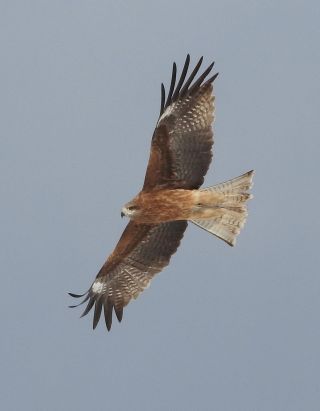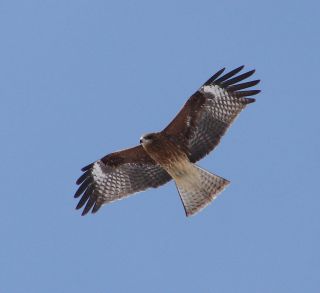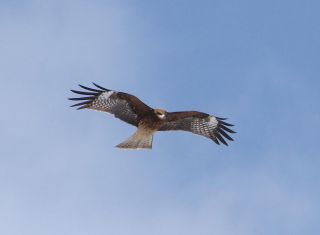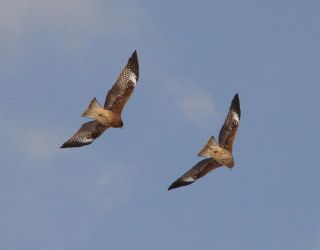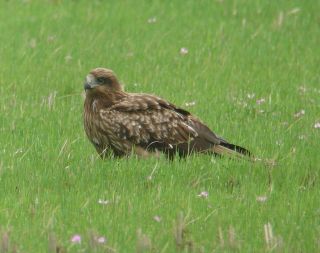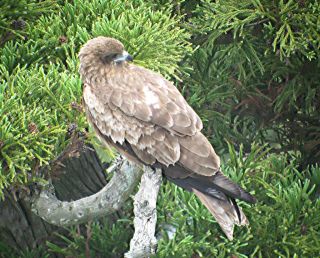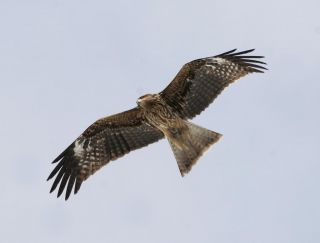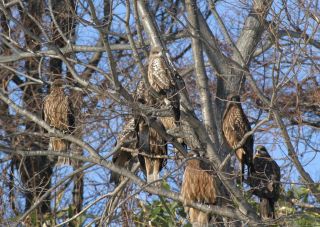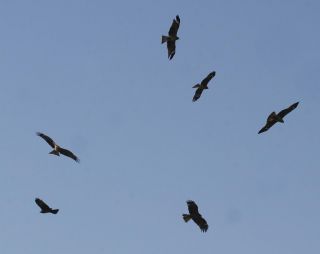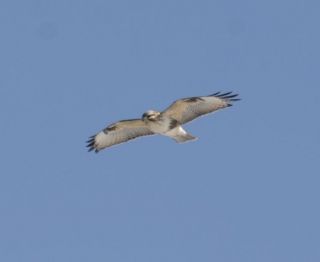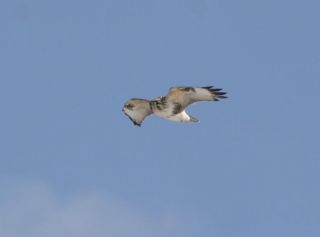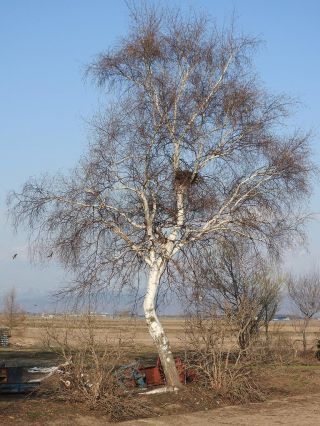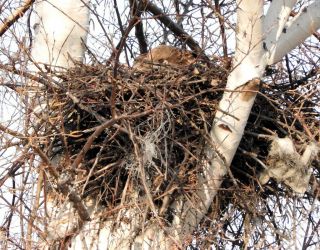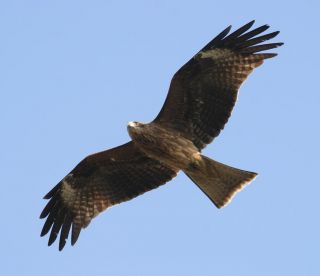A Black-eared Kite's distinctive flight pattern © Mark Brazil
Japan's Ubiquitous Scavenger – The Black-eared Kite
By Mark Brazil | Jun 30, 2016
It is summer in Hokkaido. At last the air feels warm, warm enough to tempt up the sailplanes and the gliders over the Ishikari River plain, and to waft dandelion seeds, willow fluff and spiderlings high into the air.
Overhead, silent as a spiderling’s gossamer thread adrift on the breeze, a spread-winged kite tips its head and glances down at me from a cloudless sky. I am only of passing interest for a kite.
As the kite peers down, it twists its tail in a subtle unhurried motion. Time is on its side as it peruses me. The gentle movement that begins at the base of its tail is barely perceptible, but it transmits along the length of those long, broad rectrices and translates into an elegant twist at the fanning tail tip that sends the bird into a banking curve. The kite’s outstretched wings enfold the warm gentle breeze and on it the kite quickly rises higher still, its twisting tail, first appearing square-ended, now lightly notched, steers the way and the bird drifts nonchalantly away above the farmland to a nearby woodland edge.
I am already forgotten, the kite’s attention is even now elsewhere as it dreams of food. In its turn the kite is of little interest to other birds nearby, it was never a threat to them and they have already forgotten it’s passing – if they even noticed it.
Whereas the outline of a sparrowhawk, goshawk, falcon or eagle will set most woodland birds and even waterfowl tolling their alarm calls to one another out of fear and apprehension, or even push them into paroxysms of terror and flight, kites seem not to faze them. Except for the crows. But crows are a common exception to rules and they are not so much fazed by the kite as drawn to it. There may be trouble ahead for that kite. Crows are not afraid; but they are, in human terms at least, malicious. And here comes trouble in the hatchet-beaked shape of Japan’s commonest corvid – the Large-billed Crow.
The crow wings in black as night, glossy like the sheen on a new car, and fast like one too; it is swiftly closing the gap between it and the unsuspecting drifting kite. The crow initially has the element of surprise on its side and with a raucous call it buzzes the kite aggressively from above, forcing it to jink and swerve suddenly in mid air, clumsily dodging the unwanted attention of an intelligent bird with time on its “hands”. Each time the unforgiving crow swoops back and forth, first above, then below and now from the flank, towards the kite, I am reminded of a classroom bully. It has no purpose other than malice and spite; nothing to gain except a thrill. The kite isn’t carrying food, so there is nothing for the crow to steal; furthermore the crow, despite its monstrous bill, has little chance of preying on the kite. This is purely harassment.
Time after time the kite dodges the crow, slipping sideways and away, twisting, lifting, surging suddenly upwards above it on drafts of air that the less sensitive crow seemingly cannot fathom. It climbs above the crow once more, gaining, at last, the advantage of higher “ground”. Whereas at first the crow held the element of surprise, then it had the bully’s unwavering persistence, now it looks foolish. The kite makes this final escape look effortless; at least it’s wings aren’t flapping in a frenzy like the crow’s, yet each time it dodges the crow the kite lets out a peevish tremulous whistle into which I read both annoyance and frustration: a cry of “why are you bothering me?” Eventually the crow bores of its bully’s game of harass-the-kite and flaps off to bully someone else. Meanwhile the miffed kite, silent once more, glides away and disappears over the woodland, perhaps to return to its nest.
Although kites are most definitely classified as birds of prey, paradoxically they are not actually predators. That is why, when I watched a kite make a long sweeping stoop down the southern flank of Kamuishiri-dake (a 930 m peak northeast of Sapporo), I knew that it did so not in search of food, but with some other intent. This kite seemed out to impress, and lo and behold a second kite, appearing out of nowhere, joined it and followed in its wake toward a distant tree on a further slope. Though a little late in the season this looked suspiciously like courtship, the leader out to impress the follower with its aerobatic skills.
Unlike their mammal-, reptile- or bird-hunting relatives, kites are scavengers. They share piercing eyesight with their more predatory raptor cousins, but unlike them they have weak feet and tiny, puny bills. Theirs is an aerial pursuit of the dead. You’ll find them soaring carelessly over almost any open area of farmland, drifting along casually above any river, estuary or stretch of shoreline.
Watch awhile and you may observe the kite’s moment of recognition. It’s seemingly endless silent gliding flight ends abruptly in a tight banking turn, it makes a sudden spiralling descent to earth, and lands abruptly. There is a brief moment when it appears ungainly, but once it furls its great wings it regains its composure and soon it is scavenging at the corpse of a spent frog, a road-killed rodent or a tide-washed fish. Amphibians, reptiles, mammals and birds, along with earthworms beetles and bugs, they are all grist for the kite’s mill – as long as they are dead.
Japan boasts another raptor very similar in size to the ubiquitous Black-eared Kite, but differing in both its plumage and its habits. At a glance, the Eastern Buzzard may be mistaken for a kite, especially when perching quietly atop a roadside utility pole, but take a closer look and you will notice significant differences. The proportions and general appearance, the brown tones, are similar, but a look at the tail will reveal that the buzzard has a short rounded tail in contrast to the kite’s long tail with a notched tip.
In flight, the buzzard’s wings are broad and rounded, whereas the kite’s are long and broad. When seen from below, the kite sports prominent pale panels across the bases of the underside of the primary wing feathers, and from above it has broad pale panels across the upper wing. At close quarters, the dark patches of feathers on each side of the head, the black “ears” that give the kite its name are readily visible.
The Eastern Buzzard has a plainer, gentler looking face (though that belies its nature) and dark flank patches on its otherwise pale underparts. The buzzard is a true predator, albeit of the sit-and-wait persuasion. It watches, for its small rodent prey, from a prominent perch, which it most often spots, then swoops down to capture and kill on the ground. While the buzzards waits for prey then swoops, the kite quarters low over the ground for ever searching, it’s wing beats slow and measured, the fingers of its primaries spread widely as if grasping outwards for each iota of lift that it can find. It picks up a breeze and rises, drifts and turns with a mere twist of its long tail.
Buzzard and kite; they both range so widely in Japan, appear so similar in many respects, and they share much the same environment, yet they life such different lives.
Outro
If you have read this far, then you may enjoy my previous articles, including recent offerings such as: Oriental Stork Making a Comeback in Japan (May 2016); Daijugarami: Stepping Stone to the Arctic (April 2016); Whale Watching Japan-style: Zamami (March 2016), Snow Monkeys & Cranes of Japan: Spectacular Winter Wildlife (February 2016), Amami Night Safari (January 2016), Life at the Water’s Edge (December 2015), and The Bird that Saved Me from Death (November 2015).
These Wild Watch articles, and many more, can be found on this website, and on our Facebook page (please do visit and hit the “Like” button).
Author, naturalist, lecturer and guide, Dr Mark Brazil has written his Wild Watch column continuously since April 1982. All Wild Watch articles dating back to 1999 are archived here for your reading pleasure.
A collection of Mark’s essays The Nature of Japan and two handy pocket guides The Common and Iconic Birds of Japan and The Common and Iconic Mammals of Japan have been published and are also available from www.japannatureguides.com

